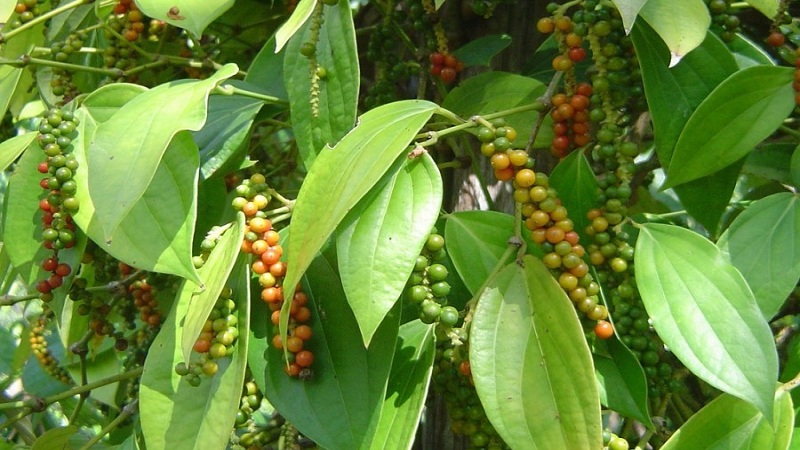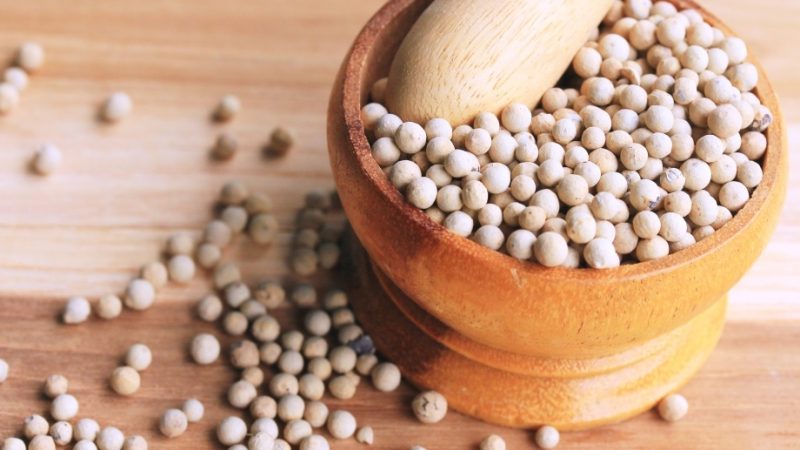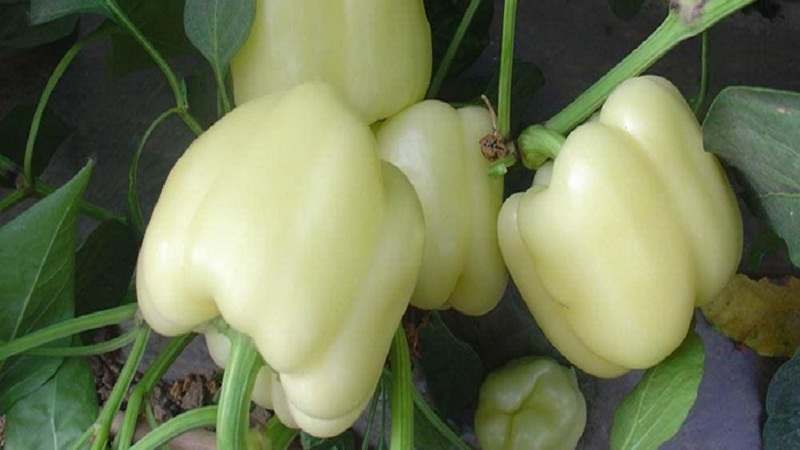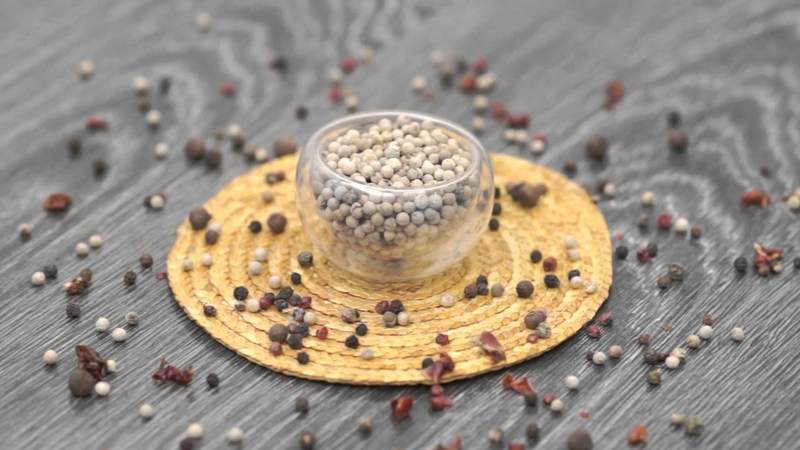What is white pepper and how is it used in cooking, cosmetology and traditional medicine
Today we'll talk about white pepper as a spice and a hybrid of Bulgarian paprika.
Peppercorns holds the palm in culinary applications. Black pepper is the most popular, followed by allspice and pink, but white is not so common. Nevertheless, this spice is able to reveal the taste of many dishes and add originality.
In this article, we will talk about growing white paprika varieties and how to get white pepper from Piper nigrum creepers. You will learn about the beneficial properties, effects on the body and how to use these products.
The content of the article
Description of the spice
White peppercorns are not collected from a particular plant species. This is the same black pepper, only fully ripe. To get the spice, they specifically wait for the full ripening time and peel the fruits from the shells in several ways.
Previously, peas were soaked in sea water and the shells were removed by hand. The process was time consuming and quite labor intensive. Unsurprisingly, the cost of the spice was cosmic. Now this process is automated - the shell is removed by machine, after pretreating the seeds with steam.
reference... The outer shell of ripe Piper nigrum fruits is deep red, and the seeds are creamy with a grayish tint.
What it looks like and where it grows
The second name of black pepper is "Malabar berry"... The fruits grow on a tree-like liana, the height of which in the wild reaches 15 m.When grown on special plantations, its growth is limited to 5 m.
The plant blooms with small flowers, collected in long clusters. Drupes are formed from them. The leaves of the vine are oval, green, with a gray bloom.
Piper nigrum grows in the tropical zone. This is one of the main agricultural crops in India, on the islands of Sumatra, Sri Lanka, Borneo. The photo shows how black pepper grows on a vine.

Chemical composition
The table shows a set of vitamins and minerals of white peppercorns.
| Name | Content | Norm |
| Vitamin B1 | 0.022 mg | 1.5 mg |
| Vitamin B2 | 0.126 mg | 1.8 mg |
| Vitamin B6 | 0.1 mg | 2 mg |
| Vitamin B9 | 10 mcg | 400 mcg |
| Vitamin C | 21 mg | 90 mg |
| Vitamin PP | 0.212 mg | 20 mg |
| Potassium | 73 mg | 2500 mg |
| Calcium | 265 mg | 1000 mg |
| Magnesium | 90 mg | 400 mg |
| Sodium | 5 mg | 1300 mg |
| Phosphorus | 176 mg | 800 mg |
| Iron | 14.31 mg | 18 mg |
| Manganese | 4.3 mg | 2 mg |
| Copper | 910 μg | 1000 mcg |
| Selenium | 3.1 μg | 55 mcg |
| Zinc | 1.13 mg | 12 mg |
KBZHU
Nutritional value of white peppercorns:
- calorie content - 296 kcal;
- proteins - 10.4 g;
- fats - 2.1 g;
- carbohydrates - 42.4 g;
- fiber - 26.2 g;
- water - 11.42 g.
Taste and aroma
White peppercorns without an outer shell have a pleasant and less pungent flavor compared to black pepper. The aroma is subtle, but quite tangible.
The benefits and harms of white pepper

White peppercorns have many useful properties:
- normalizes the work of the cardiovascular and nervous systems;
- thins the blood, reducing the risk of thrombosis;
- regulates the digestive system;
- cleans the digestive tract of toxic substances and removes toxins;
- increases the body's defenses;
- speeds up metabolism;
- prevents the formation of cancer cells;
- freshens breath, eliminates bleeding gums, kills bacteria;
- helps to recover from severe infectious diseases;
- removes worms;
- increases sex drive;
- has antipyretic properties;
- has a diuretic effect;
- increases the production of hemoglobin;
- activates the work of the pancreas.
White peppercorns can harm people with stomach ulcers, gastritis, kidney inflammation, and anemia.
Application
White peppercorns are primarily used in cooking as a spice to enrich the taste of meat, fish and vegetable dishes. Beneficial features, a set of vitamins and trace elements allow it to be used in folk medicine and cosmetology.
In cooking
White pepper is suitable for cooking meat, fish, vegetable dishes and sauces.
Ground pepper is subjected to minimal heat treatment to preserve flavor and aroma. They are used to season ready meals. White peppercorns are added at the beginning of cooking, and taken out at the end.
reference... Experienced chefs advise to grind the peas before use, since the product loses its aroma during long-term storage.
Ground spice enriches the taste of veal and beef, white fish and vegetables. Soups, stews, fish soup, goulash, filling for savory pies are seasoned with pepper. Due to its rich aroma, the seasoning is not suitable as a component for sweet dishes and drinks.
In folk medicine
White pepper has been used as a medicinal drug since the days of the ancient Indians. The spice was used to treat the upper respiratory tract.
Today the spice is used in pharmacology. The extract and powder are added to the composition of ointments with a warming effect, antiseptic and anti-inflammatory drugs.
Ointments with white pepper are effective in the treatment of pathologies of the musculoskeletal system: arthritis, radiculitis, osteochondrosis. Rubbing helps relieve vasospasm and improve blood circulation in ARVI.
In folk medicine, white pepper infusions are actively used to get rid of urolithiasis, pharyngitis, bronchitis. Tincture with honey liquefies phlegm, promotes its excretion, and has a disinfecting effect.
Alcohol tinctures help to cure sore throat, remove mucus from the respiratory tract. Compresses based on infusion help with sprains.
In cosmetology
White pepper is included in the composition of face masks, the action of which is aimed at increasing the tone and regeneration of the skin. Due to its vasodilating properties, the spice is added to anti-cellulite products, masks to accelerate hair growth and strengthen the hair follicles.
How to choose

When choosing white pepper, pay attention to the color and aroma of the spice first. The color of the peas should be creamy beige. When ground, pepper acquires a brownish tint.
Sometimes whitewashed peppers are on sale, and the peas resemble small pearls. To achieve this effect, some manufacturers use hydrogen peroxide or lime solution for bleaching. This treatment results in a loss of essential oils, aroma and taste.
A pronounced gray tint indicates that the pepper harvesting technology was previously violated, or its expiration date has expired.
To determine the freshness of a spice, try crushing a pea with your fingers. A high-quality product will fall apart into several fractions (or at first it will flatten and then turn into crumbs), while old seeds will turn into powder.
It is preferable to make ground pepper at home using a mill. But in stores they also sell ready-made spice in bags. Check the integrity of the packaging, feel it to see if there are any lumps inside, which indicate that the product is caked.
How to store
The taste and aroma of white peppercorns lasts for two years. The spice is stored in sealed jars and placed in a dark, dry place out of the reach of sunlight.
Contraindications
White peppercorns are not recommended for use in food when:
- diseases of the gastrointestinal tract (gastritis, ulcer);
- pancreatitis;
- kidney pathologies;
- inflammatory processes in the bladder;
- depression and other disorders of the nervous system;
- anemia;
- allergies;
- pregnancy and lactation.
White bell pepper
White bell peppers are not a separate species, but a group of varieties and hybrids. The white color of the fruit indicates technical (incomplete) ripeness. By the time of full ripening, the fruits acquire a creamy, yellow or red hue, depending on the variety.
A distinctive feature of white bell pepper is that it contains a large amount of vitamins and minerals in unripe form. Of all the varieties, the product of Dutch breeders called the White Bell is considered to be truly white. Ripe fruits take on an ivory hue.

Varieties
Popular varieties and hybrids of white bell pepper:
- White bell... Dutch hybrid. At first, the fruits are white, and as they ripen, they become elephant-colored. Medium yield, large peppers. The palatability is average, as is the case with many Dutch varieties.
- Belozerka... Mid-season variety, ripens on day 115. The color in technical maturity is cream, in biological it is deep red. Productivity - 1.5-2 kg / m². The taste is pleasant, refreshing.
- Snow White... Fruits ripen early, 110 days after planting seedlings. Fruit color in technical maturity is white-green, biological color is red, saturated. The taste is pleasant, the aroma is not pronounced. Productivity - 3-4 kg / m².
- The star of the east is white. An early ripe hybrid with large fruits. The color ranges from white-green to rich yellow. Up to 7 kg are collected from 1 m².
- Ivanhoe... One of the new early maturing varieties. Fruits appear on the 103-110 day. Unripe peppers are creamy white and turn orange or red as they ripen. Up to 7 kg are collected from one square meter.
- Lumina... Quite popular, non-capricious variety in cultivation and care. Fruits are medium in size, weighing 110 g. The color varies from white-green to pinkish-golden. The taste is pleasant, the pulp is juicy.
- The lightning is white. Mid-season variety. Fruits are small, weighing up to 60 g. The color of the peppers varies from white-green to dark red. The taste is excellent, refreshing, the aroma is not too intense. Up to 7 kg are collected from one square meter.
Growing features
Compliance with the rules for growing white pepper varieties allows you to get a rich harvest:
- Preparing seeds for seedlings is a mandatory step. To do this, they are heated in an oven at a temperature of 60 ° C and kept in a solution of potassium permanganate.
- Before sowing, the seeds are kept in a wet cotton cloth for up to seven days.
- The seedling soil should be nutritious, marked "for tomatoes and peppers."
- Cups are placed in a sufficiently lit place, but not in direct sunlight. Since pepper is a capricious culture, it does not tolerate a change in conditions, it is not recommended to transfer seedlings from place to place.
- Watering is regular and moderate as the soil dries, preferably in the morning.
- Periodic feeding is required.
- The transplant is carried out after the appearance of three true leaves. It is advisable not to bury the seedlings, but to leave them at the level of the roots.
- Disembarkation begins in early June. The distance between the rows is half a meter, between the bushes - up to 25 cm.
- The choice of location plays an important role. Culture loves the sun and warmth, is afraid of drafts and shade.
- After planting, the soil is watered and mulched with peat or sawdust to prevent drying out.
Reference. The seeds of hybrids do not need disinfection and soaking. This procedure is for hand harvested seed.
Properties of white bell pepper

White sweet peppers are endowed with the same beneficial properties as fruits of other shades:
- immunostimulating action;
- replenishment of the deficiency of vitamins and minerals;
- optimization of the digestive system;
- acceleration of metabolism;
- vascular cleansing and blood thinning;
- antioxidant action;
- elimination of excess cholesterol;
- regulation of body weight and reduction of body fat;
- normalization of the endocrine system;
- prevention of intestinal infections and diarrhea.
Application
The fruits of white peppers are suitable for fresh and canned consumption. Vegetable salads, stews, sauces, lecho are prepared from them. Peppers are baked over a fire, pickled, stuffed, stewed, dried.
In folk medicine, freshly squeezed juice is used, which has an anti-inflammatory effect. Gargling with diluted oral juice can help relieve stomatitis and gingivitis. A glass of juice with a tablespoon of honey will eliminate inflammation of the lacrimal sac.
Regular consumption of sweet pepper juice will help restore thyroid function due to its high iodine content.
A glass of juice three times a day will help keep your pancreas working and lower your blood sugar.
Reviews

The impressions of people from the use of white peppercorns and sweet peppers of white varieties are positive.
Maria, Murom: «I like to add various seasonings and spices to my dishes. Not so long ago I discovered the wonderful taste of white pepper. I always buy it in the form of peas and grind it in a mill before seasoning the dish. The spice favorably sets off the taste of my favorite bechamel sauce. To understand what it is, you should try at least once. "
Vladimir, Volgograd: "I have solid experience in growing vegetables in a greenhouse. From time to time I try new varieties in practice. Last year, the choice fell on a white bell pepper called Lumina. Now I recommend it to all the gardeners I know. The variety is unpretentious to care for, the peppers are beautiful in color. Initially, they are white with a greenish color, and as they mature, they turn yellow with a golden-pink tint. "
Read also:
Conclusion
At the mention of white pepper, a well-known spice immediately comes to mind, and few people know about the existence of white bell pepper. Both of these products have many beneficial properties and are often used in cooking and traditional medicine. Ground white pepper is even added to the composition of cosmetic and pharmaceutical products.
Growing hybrid varieties paprika - not an easy occupation, but with the right approach it allows you to get a rich harvest.